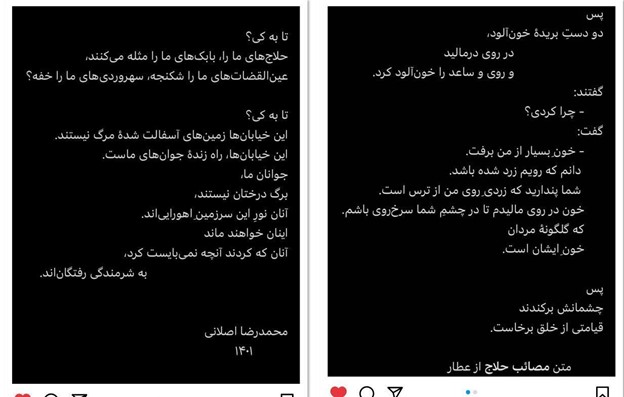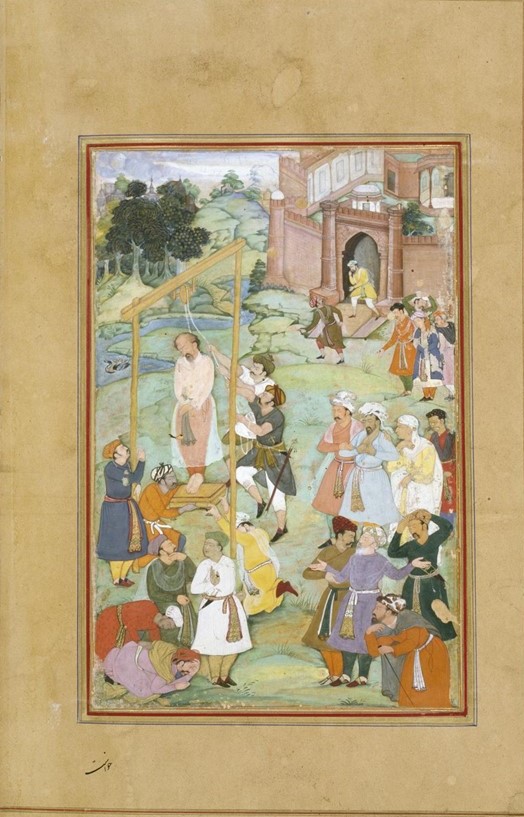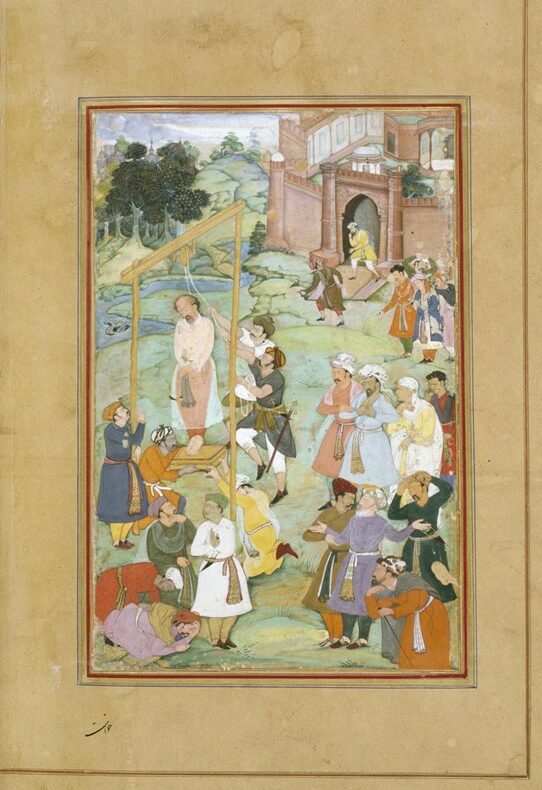Systematic resistance through the aesthetic and intellectual efforts of fearless voices that defend human rights, moral courage and basic human integrity has a long history in Islamic literature. Statements extolling the virtues of ‘infidelity’ in Iranian social media after Mahsa Amini’s brutal murder are not unheralded but backed by a rich Persianate antinomian literary tradition.

a popular Iranian footballer who has been supporting the recent protests.
“If people like you are Muslims and patriots, O God, turn me into an unbeliever.”
Encountering ʿAyn al-Qużāt’s Tamhīdāt in Iran’s Antagonism of Mullocracy
The brutal murder of 22-year-old #MahsaAmini, who was violently arrested for allegedly not abiding by Iran’s strict rules of dress code or hijab, reopened some old wounds that, this time, were ripened enough to start a syntactic feminist movement opting for human rights in Iran. The unfair behaviour of the ‘morality police’ and the strict Islamic dress code of the Islamic Republic generated a chain of reactions about the way women are treated on a daily basis in Iran. As I was following the news on social media and the responses to the tragic state of affairs, I realised that the language used by the protesters is familiar to me. I began to think of the chapter on īmān (“belief,” “faith”) and kufr (“unbelief”) in Tamhīdāt (“Preludes”), a work by the Persian mystic philosopher ʿAyn al-Qużāt Hamadānī (executed in 1131). In his philosophical pursuit, ʿAyn al-Qużāt poses acute religious questions while constantly challenging the order of religious conduct and the dominant religious hierarchy of his society. Being a revisionist truth seeker, ʿAyn al-Qużāt refutes the theological reasoning predominant in Islamic jurisprudence and becomes a pupil of Aḥmad Ghazālī (d. 1126) –a Sufi mystic – whose spiritual guidance and teachings on mystical love deeply influence his worldview. Influenced by this mystical education, he writes Tamhīdāt, in which the emphasis on pure love of God and divine oneness is incarnated in the dichotomy of belief and unbelief. He embodies unbelief as Iblīs (Satan) who refused to prostrate before Adam as he worshipped only God, signalling a mystical reading of monotheism.
However, what strikes me is not merely the transcendent mystical understanding of ʿAyn al-Qużāt, but his use of anti-cleric rhetoric to question religious authoritarianism and orthodox religious authorities. He suggests that people, who in his opinion, are strangers (بیگانگان) with Truth and authentic religious experience should transgress the confines of orthodoxy in order to acquire insight into their own Truth. Among ʿAyn al-Qużāt’s teachings on the ontology of religious belief, his emphasis on the concept of unbelief, his urge to scrutinize it, and the phenomenological call to acquire the ‘true unbelief’ –a particular form of ʿAyn al-Qużāt’s categorization of unbelief– signals his dissatisfaction with the domineering categorisation of ‘Muslim’ as opposed to ‘unbeliever’ offering an inherently binary disposition of ‘belief’. To abandon the inauthentic religious inclinations, he proposes that one needs a touch of Divine love and the will to seek beyond the categories of belief and unbelief. He desires a paradoxical unity composed of these two concepts.
Have you not heard from the great one who said, “They sent a hundred thousand poles of prophecy to people so that they become familiar, and all the strangers did not find a particle of familiarity?’ Alas! If they sent a particle of love from His presence, all strangers would find familiarity, and all would see how the strangers found acquaintance. Alas! It suited that a world would remain negligent, far from its truth.”
In another paragraph he writes:
I became an unbeliever of God’s religion and unbelief is obligatory upon me. Observe this great one (referring to Manṣur-i Ḥallāj), how he excuses this [unbelief]. How I wish I was the unbelief that was his religion.
Deprived of spirituality and mystical love, the conventional religious practices, and the teachings of theologians are at odds with the Truth and ʿAyn al-Qużāt’s understanding of faith and belief. In his view, orthodox faith stripped of personal connections with the Truth results in an inclination to unbelief that drives one farther away from the source of Truth. Thus, he opens the case for unbelief and aims to deconstruct the dominant understanding of this concept. Consequently, he is executed on account of his heretical teachings at the age of 33.
Iran’s Recent Protests
The same play on language prevails in Iran’s recent series of protests against the theocratic totalitarianism of the government that has cultivated an oppressive culture of religious supremacy. Fed up with the prevailing hypocrisy, corruption, and tyrannical behaviour of the state, the opponents of the Islamic Republic seek refuge in ‘unbelief’ in the same way that ʿAyn al-Qużāt seeks Truth in this concept. One of the popular tweets that I came across (Figure 1) translates as a devout imploration for unbelief as long as it construes in a different manner of religiosity.
We can see the invisible footprints of the medieval freethinker in kindling the religio-political subjectivity of the protesters. The uprising in Iran exploits a rich catalogue of antinomian themes, motifs, and imagery sensitive to the nuances of socio-political constructs, which is entangled in a web of power and meaning. On account of this marginal but historically rich tradition of anti-clerical thought from mystical theology, an authentic synthesis of ideas and discursive practices is offered. The so-called blasphemy in the Persian anti-cleric tradition is no longer merely blasphemous It opens the door to a textual carnivalesque where the practices, rites, and rituals of Sharia-oriented orthodoxy are severely criticised.
Another example worth mentioning is an Instagram post by Mohammadreza Aslani (1943), an Iranian filmmaker, art theorist, and poet. In his post, he expresses his opinions about the recent uprisings and the violent repression from the state. He refers to Farīd al-Dīn ʿAṭṭār’s (d.ca. 1221) account of Ḥallāj and his tragic execution. In this account, Ḥallāj washes his face with his own blood to hide his yellow face that might be mistaken for fear. Glorifying Ḥallāj’s courageous acts who was unjustly executed for religious and political charges, Aslani uses Ḥallāj’s persona to embody his socio-political critique. Leaning on the ‘infidel’ body of Ḥallāj, the ultimate martyr of the Sufi tradition, he uses a parallel account to illustrate further his dissatisfaction with the theocratic ruling system in Iran. Aslani goes on and asks:
Until when are our Ḥallājes and our Bābaks being slaughtered to become examples?
Torturing our ʿAyn al-Qużāts? Suffocating our Suhrawardīs?


There are numerous examples of familiar language that aim to criticize oppression and search for different modes of expression for reality free from discrimination and injustice. Engagement in the current protests in Iran with an antinomian language, reminiscent of medieval Islamic literature, demonstrates the relevance of the Persian antinomian literary heritage. It also shows the potential of this heritage for creating a hermeneutical space for demanding curtailed human rights through dialogue.
Selected literature:
ʿAṭṭār, Farīd al-Dīn, Farid ad-Din ʿAttār’s Memorial of God’s Friends: Lives and Sayings of Sufis, translated by P. Losensky, New York: Paulist Press, 2009.
ʻAyn al-Qużāt al-Hamadānī, ʻAbd Allāh ibn Muḥammad. Tamhīdāt. Ed. ʻAfīf ʻUsayrān, Tehran: Manūchihrī, 1373/1994.
Böwering, G., in Encyclopaedia Iranica, s.v. ʿAyn-al-Qożāt Hamadānī.
Dabashi, Hamid. Truth and Narrative: The Untimely Thoughts of ʿAyn Al-Quḍāt Al-Hamadhānī. London / New York: Curzon Press, 2016.
Griffel, Frank. Al-Ghazali’s Philosophical Theology. Milton Keynes UK: Lightning Source UK Ltd., 2018.
Lewisohn, Leonard, ed., Hafiz and the Religion of Love in Classical Persian Poetry (International Library of Iranian Studies; Iran and the Persianate World 25). London / New York: I.B. Tauris, 2010.
Ritter, Hellmut. The Ocean of the Soul: Men, the World, and God in the Stories of Farīd Al-Dīn ʻAṭṭār. Translated by John O’Kane, and Bernd Radtke, Leiden: Brill, 2013.
Seyed-Gohrab, A. Asghar. Martyrdom, Mysticism and Dissent: The Poetry of the 1979 Iranian Revolution and the Iran-Iraq War (1980-1988). Berlin: De Gruyter, 2021.
© Fatemeh Naghshvarian and the Beyond Sharia ERC Project, 2022. This project has received funding from the European Research Council (ERC) under the European Union’s Horizon 2020 research and innovation programme (Grant agreement No. 101020403). Any unlicensed use of this blog without written permission from the author and the Beyond Sharia ERC Project is prohibited. Any use of this blog should give full credit to Fatemeh Naghshvarian and the Beyond Sharia ERC Project.


